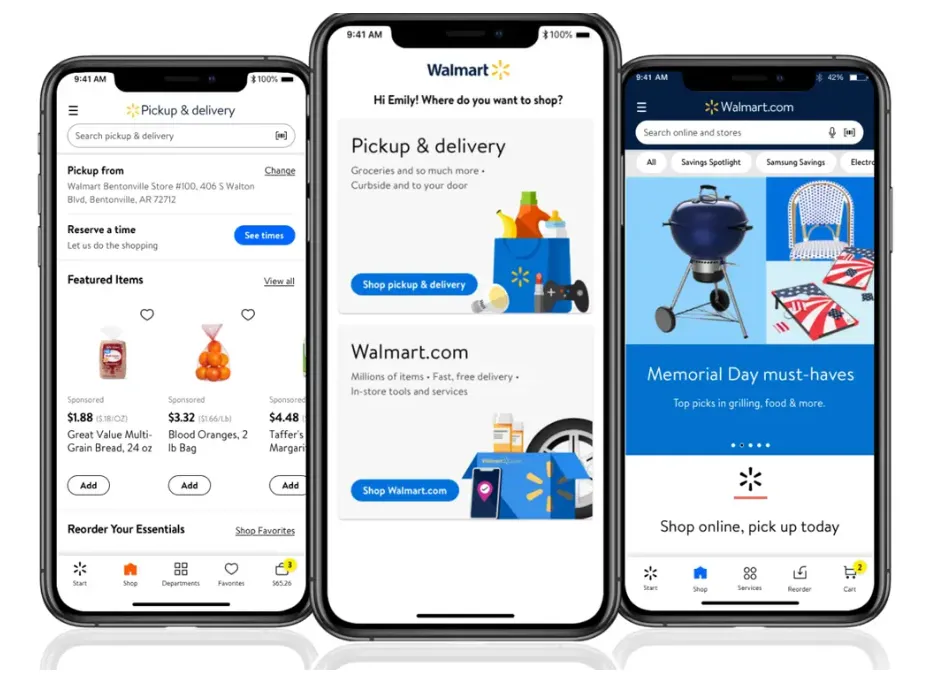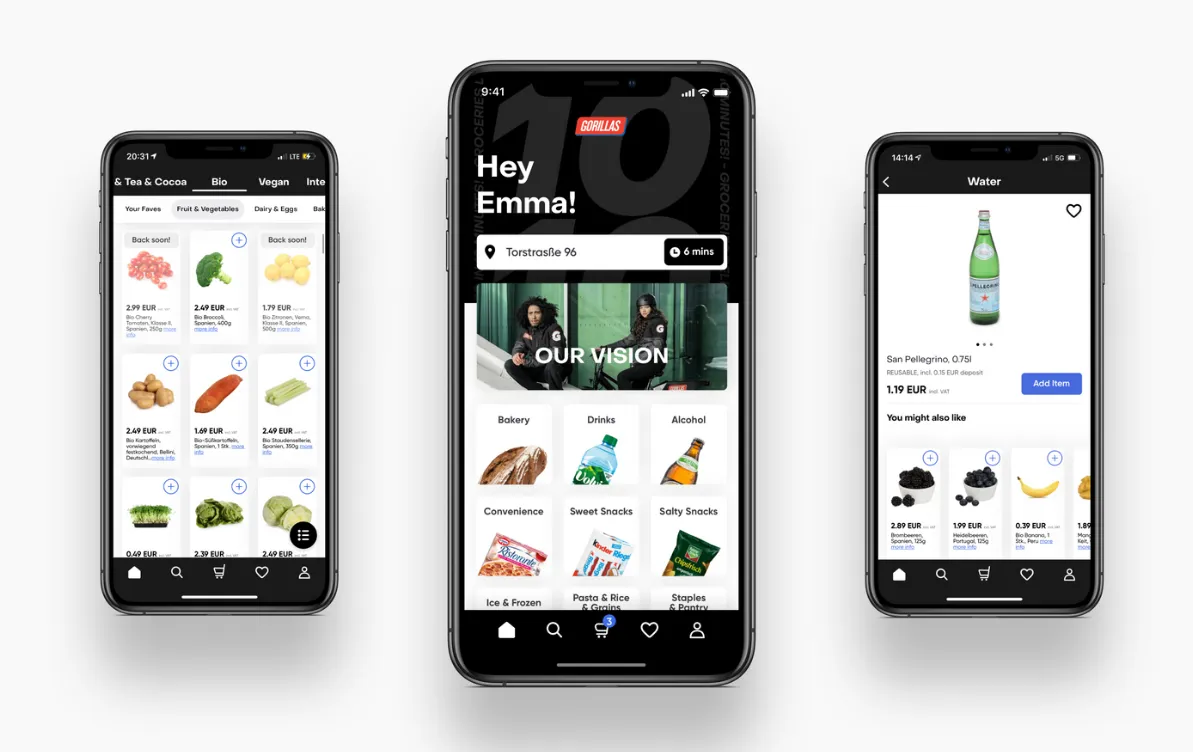Online grocery shopping with home or office delivery has become a common practice for most people. And it's not surprising, considering how many advantages it provides: a wide selection of products, the ability to compare prices and features without leaving home.
2020-2021 became a period of intensive growth for the grocery delivery market. Due to quarantine restrictions, people couldn't freely visit offline stores. This prompted store owners to transform their businesses, emphasizing online sales and delivery.
Although the COVID-19 pandemic officially ended, the inclination towards online shopping with delivery has persisted. An app is essential if your business is related to online grocery retail. Our team at Lampa Software specializes in e-commerce solutions development, providing digital products to enhance your business operations.
We have prepared an article that covers the following:
The importance of grocery app development.
App features necessary for its effective operation.
Timelines and the grocery app development cost.
Choosing a professional development team.
Monetization strategies.
Successful grocery mobile apps.
But before we dive into the main content, let's find out what a grocery app is all about.
What is a Grocery App?
This digital solution allows users to order groceries online for delivery. Typically, such apps operate on a subscription basis. The model involves a monthly or annual fee that users must pay. We'll discuss the main types of apps later.
Aggregators
These apps provide users with a list of nearby stores. How do they work?
A customer selects a store from the list.
Adds the necessary products to the cart from the online catalog.
Places the order and makes a payment.
After the order is confirmed, the buyer can track its execution in real-time.
Marketplaces
These are online platforms for buying and selling groceries. There is an opinion that these two types of apps are similar. But that's not the case. An aggregator is a mediator who does not engage in the transaction. A marketplace is not just a mediator but also a participant in the transaction. It organizes the sale/reservation of the product and handles logistics processes.
Many grocery store chains have their own applications, allowing customers to make purchases and order delivery. Users can also see a list of nearby supermarkets, participate in loyalty programs, and receive information about discounts.
Why is Now the Perfect Time for Grocery App Development?
The e-commerce market is steadily growing. According to the analysis of U.S. Department of Commerce data published by Digital Commerce 360, the volume of e-commerce sales in the U.S. reached $1,034.14 billion in 2022. This is 7.7% higher than the figure in 2021, which was $960.44 billion.

Source: Digital Commerce 360
With the growth of online sales, the needs of regular customers also increase. They require freedom in choosing products and making purchases. More and more consumers prefer mobile apps over websites because they offer adaptability, convenience, and speed in achieving their goals.
Therefore, the key to selling your product is grocery ordering app development.
Such solutions are gaining popularity. According to Apptopia, in the first quarter of 2022, the number of user sessions in grocery apps broke the record of 2020 by 13%.

Source: Apptopia
With a grocery app, you can improve user experience and customer loyalty, increasing sales and profit.
Core Features of a Robust Grocery App
For a service that sells and delivers groceries, you'll need specific functionality for customers, couriers, and administrators.
For Customers:
Registration: The first step a user takes when entering the app is authentication. In a delivery app, registration should not require much effort—simply providing a phone number or using popular social networks for login is sufficient.
Search and Filters: Typically, only a few selected stores are presented on the home screen. However, this is only a small part of the entire variety of choices. A search function needs to be added to allow users to find other grocery stores.
Store Catalog: It's impossible to imagine a grocery delivery app without the ability to choose a grocery store. To start, you need to partner with dozens of local stores so that people have a variety to choose from and you have multiple revenue streams.
Payment: Multiple payment options are also an integral part of the app. It's necessary to integrate payment gateways, which can be classified into two types: classical ones requiring a business account at a bank, suitable for large enterprises, and modern ones working with a regular bank account for receiving payments but implying higher commissions.
Geolocation: To automatically determine the user's location, integration with Google Maps is necessary.
Customer Support: To resolve disputes, providing several support options is essential. For simple questions, chatbots are convenient, and for complex issues, users can contact an operator.
Chat with Courier: A feature allowing users to inquire about the reason for a delivery delay or inform that they will pick up the order at the entrance.
Push Notifications: To inform users about changes in the order status and understand at which stage the delivery is. This allows sending personalized offers and promotions.
For Administrators:
Order Management Panel: Store employees see and process all incoming orders.
Catalog Editing: To exclude items that are currently unavailable for order or, conversely, add new items. It's also possible to edit photos and descriptions of products.
For Couriers:
Registration: To allow the system to understand who exactly is delivering orders; usually, a phone number is used for login.
Order List: Here, all currently available orders are displayed with the store name, the courier's distance, and the delivery time. This allows the courier to choose the most suitable order and take it for delivery.
Order Delivery Status: The status changes every time the courier takes an order, waits for the order to be prepared, heads to the customer, and hands over the package. Simultaneously, the status is updated in the customer's app.
Order History: The goal is to track the number of completed orders.
Cost Factors in Grocery App Development
It's important to understand that the cost depends on the team structure and tech stack.
From the perspective of the app development company, the team typically consists of a Product Owner, a Scrum Master, 1-2 application developers for iOS and/or Android, 1 backend developer, a tester (QA), and a UI/UX designer. The number of specialists involved affects the final price of grocery delivery application development.
The tools and platforms used to create the software product influence its ultimate cost. Therefore, pricing is discussed individually with each client.
Monetization Strategies
The goal of a commercial project is to generate profit, so the app needs to be monetized. There are three models that will help you not only recoup the costs of grocery mobile app development but also consistently earn:
Commission: Customize it depending on the average revenue of a restaurant or supermarket.
Paid Delivery: If the previous method involves charging fees to restaurants and stores, this one charges customers. The delivery cost can be fixed or calculated based on the delivery area, demand, and order amount.
Advertising: In such apps, advertising is an opportunity to appear on the main screen in the list of recommended sales points. Establishments get customers, and you get profits.
Earning significant money using only one method will be challenging, so it is recommended to combine several at once.
Case Studies of Successful Grocery Apps in 2024
If you're contemplating grocery delivery app development, it's crucial to study competitors. We've gathered major and well-known players who have conquered the global market.
Walmart

Source: Business Insider
An American titan with an extensive assortment, Walmart holds the second position in Similarweb's "Food" category in the USA.
Walmart doesn't just sell groceries but also clothing, household appliances, and even furniture. Personalized recommendations based on previous shopping experiences, user-friendly categorization, and a search bar help users navigate the catalog with thousands of items.
Users can also add items to their favorites, quickly reorder past purchases, and pre-specify what to pack if a particular item is unavailable. After payment, the order status can be tracked in real-time on the main screen.
Instacart

Source: Behance
Another leading player in the American market, Instacart became the most downloaded grocery delivery app in the USA in 2022, with over 8 million downloads.

Source: Statista
In April 2023, Instacart's American grocery delivery and pickup service website was the most visited site in the "Food" category in the USA, accounting for 7,83% of total traffic.
Instacart collaborates with tens of thousands of stores across all states, boasting a catalog of over 500 million items. The service connects the customer, who has made a payment, with a personal shopper, who purchases the needed items and delivers them on the same day.
Users can utilize numerous filters, track order status in real-time, and communicate directly with shoppers.
Gorillas

Source: Felix Haas
Gorillas, a young player in the fast delivery sphere, was launched in Berlin in May 2020 and quickly became the most popular not only in Germany but also in the UK and the USA. About 900,000 people use Gorillas at least once a month.
The app functions as a grocery store, offering items like bread, milk, snacks, and other everyday goods. Gorillas has "dark stores" located in cities and their surroundings, usually within two kilometers of the customer, ensuring delivery in less than 15 minutes.
Conclusions
Grocery store app development is a promising direction that simplifies the grocery shopping process for consumers. For companies, it's an opportunity to expand and enhance efficiency.
Creating a grocery app is a complex and lengthy process requiring specific skills and expertise. To ensure the digital product's success, it's crucial to carefully consider its functionality and tailor it to market requirements.
Delegate development to the Lampa team. We have rich experience and knowledge and adhere to an individual approach, enabling us to create high-quality personalized products.